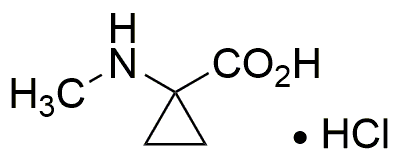N-Methylaminocyclopropane-1-carboxylic acid hydrochloride is widely utilized in research focused on:
- Agricultural Research: This compound is significant in the study of plant growth regulators, helping to enhance crop yields and improve resistance to environmental stressors.
- Pharmaceutical Development: It serves as a building block in the synthesis of various pharmaceuticals, particularly in creating compounds that target neurological disorders.
- Biochemical Studies: Researchers use it to investigate metabolic pathways and enzyme interactions, providing insights into cellular processes.
- Analytical Chemistry: It is employed as a standard in chromatographic techniques, aiding in the accurate quantification of similar compounds in complex mixtures.
- Material Science: The compound is explored for its potential in developing new materials with unique properties, such as enhanced durability and chemical resistance.
General Information
Properties
Safety and Regulations
Applications
N-Methylaminocyclopropane-1-carboxylic acid hydrochloride is widely utilized in research focused on:
- Agricultural Research: This compound is significant in the study of plant growth regulators, helping to enhance crop yields and improve resistance to environmental stressors.
- Pharmaceutical Development: It serves as a building block in the synthesis of various pharmaceuticals, particularly in creating compounds that target neurological disorders.
- Biochemical Studies: Researchers use it to investigate metabolic pathways and enzyme interactions, providing insights into cellular processes.
- Analytical Chemistry: It is employed as a standard in chromatographic techniques, aiding in the accurate quantification of similar compounds in complex mixtures.
- Material Science: The compound is explored for its potential in developing new materials with unique properties, such as enhanced durability and chemical resistance.
Documents
Safety Data Sheets (SDS)
The SDS provides comprehensive safety information on handling, storage, and disposal of the product.
Product Specification (PS)
The PS provides a comprehensive breakdown of the product’s properties, including chemical composition, physical state, purity, and storage requirements. It also details acceptable quality ranges and the product's intended applications.
Certificates of Analysis (COA)
Search for Certificates of Analysis (COA) by entering the products Lot Number. Lot and Batch Numbers can be found on a product’s label following the words ‘Lot’ or ‘Batch’.
*Catalog Number
*Lot Number
Certificates Of Origin (COO)
This COO confirms the country where the product was manufactured, and also details the materials and components used in it and whether it is derived from natural, synthetic, or other specific sources. This certificate may be required for customs, trade, and regulatory compliance.
*Catalog Number
*Lot Number
Safety Data Sheets (SDS)
The SDS provides comprehensive safety information on handling, storage, and disposal of the product.
DownloadProduct Specification (PS)
The PS provides a comprehensive breakdown of the product’s properties, including chemical composition, physical state, purity, and storage requirements. It also details acceptable quality ranges and the product's intended applications.
DownloadCertificates of Analysis (COA)
Search for Certificates of Analysis (COA) by entering the products Lot Number. Lot and Batch Numbers can be found on a product’s label following the words ‘Lot’ or ‘Batch’.
*Catalog Number
*Lot Number
Certificates Of Origin (COO)
This COO confirms the country where the product was manufactured, and also details the materials and components used in it and whether it is derived from natural, synthetic, or other specific sources. This certificate may be required for customs, trade, and regulatory compliance.

